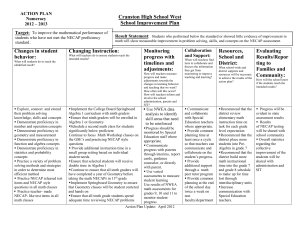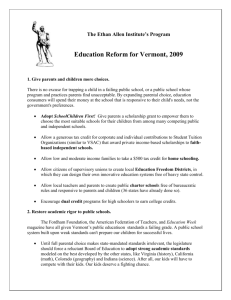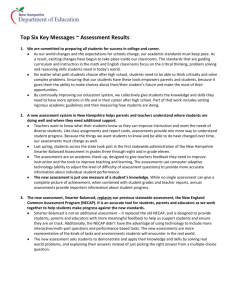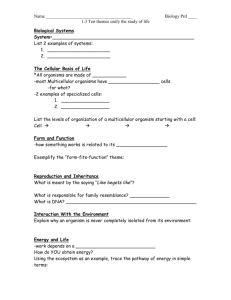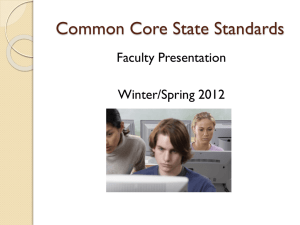Science Literacy Resources
advertisement
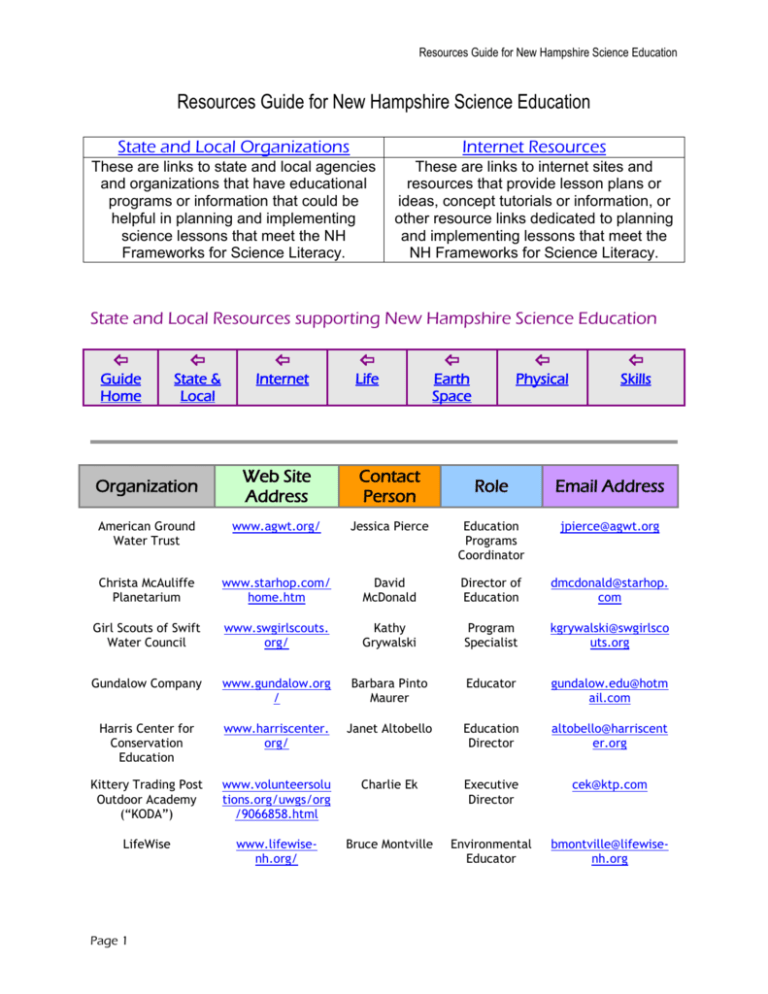
Resources Guide for New Hampshire Science Education Resources Guide for New Hampshire Science Education State and Local Organizations Internet Resources These are links to state and local agencies and organizations that have educational programs or information that could be helpful in planning and implementing science lessons that meet the NH Frameworks for Science Literacy. These are links to internet sites and resources that provide lesson plans or ideas, concept tutorials or information, or other resource links dedicated to planning and implementing lessons that meet the NH Frameworks for Science Literacy. State and Local Resources supporting New Hampshire Science Education Guide Home State & Local Internet Life Earth Space Physical Skills Web Site Address Contact Person American Ground Water Trust www.agwt.org/ Christa McAuliffe Planetarium Organization Role Email Address Jessica Pierce Education Programs Coordinator jpierce@agwt.org www.starhop.com/ home.htm David McDonald Director of Education dmcdonald@starhop. com Girl Scouts of Swift Water Council www.swgirlscouts. org/ Kathy Grywalski Program Specialist kgrywalski@swgirlsco uts.org Gundalow Company www.gundalow.org / Barbara Pinto Maurer Educator gundalow.edu@hotm ail.com Harris Center for Conservation Education www.harriscenter. org/ Janet Altobello Education Director altobello@harriscent er.org Kittery Trading Post Outdoor Academy (“KODA”) www.volunteersolu tions.org/uwgs/org /9066858.html Charlie Ek Executive Director cek@ktp.com LifeWise www.lifewisenh.org/ Bruce Montville Environmental Educator bmontville@lifewisenh.org Page 1 Resources Guide for New Hampshire Science Education Mount Washington Observatory www.mountwashin gton.org/ Michelle Cruz Outreach Educator mcruz@mountwashin gton.org NH Audubon www.nhaudubon.or g/ Karen Acerno Director – MAC Center kacerno@nhaudubon. org NH Audubon Center Prescott Farm www.nhaudubon.or g/ Cathy Duffy Program Director cduffy@nhaudubon.o rg NH Audubon Center Prescott Farm www.nhaudubon.or g/ Scott Fitzpatrick Executive Director / Educator sfitzpatrick@nhaudub on.org NH Department of Environmental Services www.des.state.nh. us Timothy Drew Public Information and Permitting Administrator tdrew@des.state.nh. us NHDES Project WET www.projectwet.o rg/ Jessica Brock Environmental Educator jbrock@des.state.nh. us NH Project Learning Tree www.nhplt.org/ Beth Lesure Professional Development Provider info@nhplt.org Sandy Point Discovery Center (NH Fish & Game) www.greatbay.org / Beth Heckman Assistant Education Coordinator beth@greatbay.org Sandy Point Discovery Center www.greatbay.org / Jay Sullivan Naturalist jay@greatbay.org Seacoast Science Center www.seacentr.org/ Perrin Cothran Chick Education Director p.cothran@seacentr. org Squam Lakes Natural Science Center www.nhnature.org / Beth Roy Educator beth.roy@nhnature.o rg UNH Globe www.globe.unh.ed u/ Jen Bourgeault Education Support jen.bourgeault@unh. edu UNH Leitzel Center Leitzelcenter.unh. edu Barbara Hopkins Associate Outreach Director barbara.hopkins@unh .edu UNH Marine Docents www.unh.edu/mari ne-education/ Mark Wiley Education Specialist mark.wiley@unh.edu Page 2 Resources Guide for New Hampshire Science Education US Forest Service www.fs.fed.us/ Susan Cox Conservation Education smcox@fs.fed.us www.fs.fed.us/r9/ forests/white_mou ntain/ Guide Home State & Local Internet Life Earth Space Physical Skills Internet Resources supporting the New Hampshire Science Frameworks. General Science Life Science Earth Space Science Physical Science Science Skills General Science Education For Teachers: http://www.syvum.com/ Online Education and interactive learning worldwide. Topics include physics, chemistry, biology, and environmental science. http://www.bbc.co.uk/schools/ks3bitesize/teachers/lessonplans/#Science Science Lesson Plans for Teachers from the BBC. http://www.teach-nology.com/teachers/lesson_plans/science/ Membership required. Teach-nology a Web Portal for Educators. http://www.teachers.net/lessons/ Lesson Bank from Teachers.net. http://www.enchantedlearning.com/categories/science/ Science activities from Enchanted Learning. http://www.svsu.edu/mathsci-center/resources_sciencesites.cfm General Science Links from Saginaw Valley State University, arranged by grade level. http://www.4teachers.org/ Free online tools and resources for integrating technology into the classroom. http://www.merlot.org/ Free resource for online teaching and learning, primarily for higher education. http://www.ceismc.gatech.edu/busyt/ Busy Teachers Website K-12. http://www.tufts.edu/as/wright_center/ The Wright Center for Science Education at Tufts University is dedicated to the creation and sharing of novel instructional techniques and interdisciplinary resources for teachers. http://www.nap.edu/readingroom/books/rtmss/index.html Resources for Middle School teachers. Page 3 Resources Guide for New Hampshire Science Education http://www.doscience.com/act_archive/ Science Activities from Do Science. http://www.edinformatics.com/math_science/math_science.htm Math Science Activity Center. http://personal.cmich.edu/~franc1m/es-geo-e.htm Earth Science/Geography education listings. http://www.mcps.k12.md.us/departments/eventscience/ curricula. Event Based Science information , books, and http://edtech.kennesaw.edu/jcheek1/default.htm Middle School Science resources from the Educational Technology Center of KSU in Kennesaw, GE. http://www.cloudnet.com/~edrbsass/edsci.htm Science lesson plans and resources. http://serendip.brynmawr.edu/sci_edu/ Science and Education from Serendip, a science support network supported by Bryn Mawr College. http://www.sciencenetlinks.com/tool_index.cfm Science Netlinks tool index http://can-do.com/science/ Science Resources from Sheppard Wade. http://www.uen.org/k12educator/ Resources for Educators from the Utah Education Network. http://www.theteacherscorner.net/lesson-plans/science/index.htm Lesson plans from the Teacher’s Corner. http://www.internet4classrooms.com/science_elem.htm Science resources for elementary school. For Students or Teachers: http://www.sln.org The Science Learning Network. Resources for inquiry based science. http://www.sciencenetlinks.com/ Resources from Science Netlinks. http://www.usgs.gov/ United States Geological Survey, your source for science online. http://www.billnye.com Bill Nye the Science Guy! http://www.globe.gov/ The GLOBE Program (Global Learning and Observations to Benefit the Environment). http://classroom.jc-schools.net/basic/science.html Online basic skill games and educational resources for K-8 students. http://www.epl.org/library/science-projects.html Science Projects on the Internet from Evanston Public Library. Guide Home State & Local Internet Life Earth Space Physical Skills Page 4 Resources Guide for New Hampshire Science Education Life Science For Teachers: http://www.iit.edu/~smile/biolinde.html Smile Program Biology Index Lesson plans separated into categories. Hosted by the Illinois Institute of Technology. http://www.fed.cuhk.edu.hk/~johnson/index.php Biology Teaching from the Chinese University of Hong Kong. http://www.bioedonline.org/presentations/ BioEd Online Presentations for a variety of topics. http://www.reachoutmichigan.org/funexperiments/agesubject/biology.html Biology resources for all levels from Reach Out! Michigan. http://biology.arizona.edu/sciconn/lessons2/lessons.html Lesson plans and activities by middle and high school teachers from the University of Arizona general biology program for science teachers. http://serendip.brynmawr.edu/sci_edu/waldron/ to High School or Middle School Students Hands-on Activities for Teaching Biology http://sciencespot.net/Pages/classbiolsn.html Biology lesson plan links from the Science Spot. http://www.nap.edu/readingroom/books/rtmss/2open.html Life science resources for middle school. http://www.project2061.org/publications/bsl/online/ch5/ch5.htm Benchmarks Online from Project 2061. http://www.sasked.gov.sk.ca/docs/midlsci/gr6ucmsc.html Ecosystems Unit developed throughout the grade levels. http://www.sciencenetlinks.com/matrix.cfm SciLinks lesson index, separated into grade levels. http://www.iit.edu/~smile/bi9008.html Lesson on the characteristics of living things. http://www.indiana.edu/~ensiweb/home.html Evolution and the Nature of Science Institute For Students or Teachers: http://serendip.brynmawr.edu/sci_edu/biosites.html Interactive Biology from Serendip. http://biology.usgs.gov US Geological Survey biological resources. http://tolweb.org/tree/phylogeny.html The Tree of Life Web Project. http://www.biology.arizona.edu/DEFAULT.html The Biology Project from the University of Arizona, an online interactive resource for learning biology. http://www.whatislife.com/principles/principles.htm Principles of Biology from What is Life site. http://www.biologycorner.com Lesson plans and resource site for science/biology teachers from The Biology Corner. http://www.estrellamountain.edu/faculty/farabee/biobk/biobooktoc.html Online Biology book hosted by Estrella Mountain Community College in Avondale, Arizona. http://www.rickhershberger.com/bioactivesite/index.htm The BioActive Site, a place to learn about life. Page 5 Resources Guide for New Hampshire Science Education http://www.zoo.utoronto.ca/able/resources/hotsites.htm Hot Biology Web Sites from the Association for Biology Laboratory Education http://www.johnkyrk.com/index.html Cell Biology animations http://science.nhmccd.edu/biol/bio1int.htm Biology interactives movies and tutorials http://www.ibiblio.org/virtualcell/index.htm The Virtual Cell Web Page http://www.wiley.com/legacy/college/boyer/0470003790/animations/animations.htm Interactive Animations from Wiley LS1 All living organisms have identifiable structures and characteristics that allow for survival (organisms, populations, & species). 1. Classification K–4 NECAP Science Target 2. Sort/classify different living things using similar and different characteristics. Describe why organisms belong to each group or cite evidence about how they are alike or not alike. 5-8 NECAP Science Target 2. Describe or compare how different organisms have mechanisms that work in a coordinated way to obtain energy, grow, move, respond, provide defense, enable reproduction, or maintain internal balance (e.g., cells, tissues, organs and systems). For Teachers: http://www.microbeworld.org/mlc/gifs/activities/pgs1-6.pdf. Creepy Critters Activity http://www.bbc.co.uk/schools/ks3bitesize/teachers/lessonplans/science/variation_offline.shtml Variation and Classification Lesson Plans http://ares.jsc.nasa.gov/Education/Websites/AstrobiologyEducation/classification.htm Classification lesson from NASA. http://www.learner.org/channel/courses/biology/support/redbio03.pdf Evolution and Phylogenetics Activity contains a classification activity http://www.teachers.net/lessons/posts/1228.html Lesson from Teachers.net http://www.iit.edu/~smile/bi9318.html A game to promote classification and observation. 2. Living Things and Organization K-4 NECAP Science Target 3. Identify and explain how the physical structures of an organism (plants or animals) allow it to survive in its habitat/environment (e.g., roots for water; nose to smell fire). Page 6 Resources Guide for New Hampshire Science Education 4. Identify the basic needs of plants and animals in order to stay alive (i.e., water, air, food, space). 5-8 NECAP Science Target 4. Explain relationships between or among the structure and function of the cells, tissues, organs, and organ systems in an organism. 5. Using data and observations about the biodiversity of an ecosystem make predictions or draw conclusions about how the diversity contributes to the stability of the ecosystem. 9-12 NECAP Science Target 8. Use data and observation to make connections between, to explain, or to justify how specific cell organelles produce/regulate what the cell needs or what a unicellular or multi-cellular organism needs for survival (e.g., protein synthesis, DNA transport, nerve cells). For Teachers: http://www.cyto.purdue.edu/flowcyt/educate/photos/cells/ Free images from Purdue University Cytometry Laboratories. https://histo.life.uiuc.edu/histo/lab/cells/text.htm Cell activity from histology lab from University of Illinois College of Medicine. http://www.cal.org/siop/lessons/LPPA.html Lesson plan for parts of a cell from Jordan High School in Long Beach, California. http://www.southerncompany.com/learningpower/pdf/The%20Living%20Cell.pdf Living Cell elementary level lesson plan from Southern Company. For Students or Teachers: http://micro.magnet.fsu.edu/cells/ Introduction to cells and viruses from Molecular Expressions. http://biology.clc.uc.edu/courses/bio104/cells.htm from University of Cincinnati. http://www.cellsalive.com/ Cells Alive! http://sun.menloschool.org/~cweaver/cells/ Cell page from Menlo School Online. 2. Reproduction K-4 NECAP Science Target 3. Predict, sequence, or compare the life stages of organisms – plants and animals (e.g., put images of life stages of an organism in order, predict the next stage in sequence, and compare two organisms). 5-8 NECAP Science Target 6. Compare and contrast sexual reproduction with asexual reproduction. Page 7 Resources Guide for New Hampshire Science Education 7. Using data provided, select evidence that supports the concept that genetic information is passed on from both parents to offspring. 9-12 NECAP Science Target 4. Explain or justify with evidence how the alteration of the DNA sequence may produce new gene combinations that make little difference, enhance capabilities, or can be harmful to the organism (e.g., selective breeding, genetic engineering, mutations). For Students and Teachers: http://www.biology.arizona.edu/cell_bio/cell_bio.html Mitosis and Meiosis and Cell Cycle from University of Arizona. http://www.biologydaily.com/biology/Asexual_reproduction Reproduction from Biology Daily site. http://www.cellsalive.com/cell_cycle.htm The cell cycle from Cells Alive.com. LS2 Energy flows and matter recycles through an ecosystem. 1. Environment 5-8 NECAP Science Target 3. Using data and observations, predict outcomes when abiotic/biotic factors are changed in an ecosystem. 9-12 NECAP Science Target 5. Using data from a specific ecosystem, explain relationships or make predictions about how environmental disturbance (human impact or natural events) affects the flow of energy or cycling of matter in an ecosystem. 6. Explain or evaluate potential bias in how evidence is interpreted in reports concerning a particular environmental factor that impacts the biology of humans. For Students or Teachers: http://www.biologydaily.com/biology/Environment Environment from Biology Daily. http://www.marietta.edu/~biol/102/ecosystem.html Environmental biology from Marietta College. http://www.funsci.com/fun3_en/exper1/exper1.htm Science experiments on environmental education in biology. 2. Flow of Energy K-4 NECAP Science Target 2. Recognize that energy is needed for all organisms to stay alive and grow or identify where a plant or animal gets its energy. 5-8 NECAP Science Target 2. Given a scenario, trace the flow of energy through an ecosystem, beginning with the sun, through organisms in the food web, and into the environment (includes photosynthesis and respiration). Page 8 Resources Guide for New Hampshire Science Education 9-12 NECAP Science Target 3. Trace the cycling of matter (e.g., carbon cycle) and the flow of energy in a living system from its source through its transformation in cellular, biochemical processes (e.g., photosynthesis, cellular respiration, fermentation) For Teachers: http://www.uwsp.edu/cnr/wcee/keep/Mod1/Flow/Intro.htm Unit on Energy Flow For Students or Teachers: http://www.geog.ouc.bc.ca/conted/onlinecourses/geog_210/210_2_5.html Introduction to Environmental Issues from a Geography class. 3. Recycling of Materials K-4 NECAP Science Target 2. Describe ways plants and animals depend on each other (e.g., shelter, nesting, food). 5-8 NECAP Science Target 6. Given an ecosystem, trace how matter cycles among and between organisms and the physical environment (includes water, oxygen, food web, decomposition, recycling but not carbon cycle or nitrogen cycle). For Teachers: http://www.fairfaxcounty.gov/nvswcd/enviroscape.htm Enviroscape Model from Fairfax County, VA. http://www.accessexcellence.org/AE/AEC/AEF/1995/freeman_ecosystem.html Building an Ecosystem Activity from Access Excellence. LS3 Groups of organisms show evidence of change over time (e.g. evolution, natural selection, structures, behaviors, and biochemistry). For Teachers: http://school.discovery.com/lessonplans/programs/greatbooks-originofspecies Lesson plans library from Discovery School. 1. Change K-4 NECAP Science Target 3. Using information (data or scenario), explain how changes in the environment can cause organisms to respond (e.g., survive there and reproduce, move away, die). For Teachers: http://www.wfpa.org/ee/wfpaee/wfpa-plt/PLT_K-/patterns_of_change_EALRs.htm Patterns of change lessons. 2. Evidence of Evolution Page 9 Resources Guide for New Hampshire Science Education 5-8 NECAP Science Target 3. Use a model, classification system, or dichotomous key to illustrate, compare, or interpret possible relationships among groups of organisms (e.g., internal and external structures, anatomical features) 9-12 NECAP Science Target 6. Explain how evidence from technological advances supports or refutes the genetic relationships among groups of organisms (e.g., DNA analysis, protein analysis ) 7. Given information about living or extinct organisms, cite evidence to explain the frequency of inherited characteristics of organisms in a population, OR explain the evolution of varied structures (with defined functions) that affected the organisms’ survival in a specific environment (e.g., giraffe, wind pollination of flowers ). For Teachers: http://evolution.berkeley.edu/evosite/search/conceptbrowse.php?audience_level=6-8 History of life concepts for grades 6 through 8. http://evolution.berkeley.edu/evosite/search/conceptbrowse.php?audience_level=9-12 History of life concepts for grades 9 through 12. http://www.evoled.org/lessons/causes.htm Teach Evolution and Make it Relevant. http://web.clas.ufl.edu/users/rhatch/pages/05-SecondaryTeaching/NSF-PLANS/4-1_ORIGIN.htm Comparison of Darwin and Lamarck’s ideas, suitable for all levels. http://www.indiana.edu/~ensiweb/lessons/mclad.html the Nature of Science Institute Lesson in making cladograms from Evolution and 3. Natural Selection 5-8 NECAP Science Target 5. Cite examples supporting the concept that certain traits of organisms may provide a survival advantage in a specific environment and therefore, an increased likelihood to produce offspring. 9-12 NECAP Science Target 9. Given a scenario, provide evidence that demonstrates how sexual reproduction results in a great variety of possible gene combinations and contributes to natural selection (e.g., Darwin’s finches, isolation of a species, Tay Sach’s disease). For Teachers: http://www.pbs.org/lifeofbirds/classroom/lesson2.html Natural selection from PBS on the Life of Birds. http://www.sciencenetlinks.com/lessons_printable.cfm?DocID=99 Introduction to natural selection from the SciLinks network. LS4 Humans are similar to other species in many ways, and yet are unique among Earth’s life forms. Page 10 Resources Guide for New Hampshire Science Education 1. Behavior For Teachers: http://biology.arizona.edu/sciconn/lessons2/lessons.html Lesson plans from the University of Arizona. 2. Disease 5-8 NECAP Science Target 4. Use data and observations to support the concept that environmental or biological factors affect human body systems (biotic & abiotic). 9-12 NECAP Science Target 6. Use evidence to make and support conclusions about the ways that humans or other organisms are affected by environmental factors or heredity (e.g., pathogens, diseases, medical advances, pollution, mutations). For Teachers: http://www.nationalgeographic.com/xpeditions/lessons/18/g912/parasites.html Lesson plans on parasites and disease from national Geographic. 3. Human Identity K-4 NECAP Science Target 1. Identify what the physical structures of humans do (e.g., sense organs – eyes, ears, skin, etc.) or compare physical structures of humans to similar structures of animals. 2. Distinguish between characteristics of humans that are inherited from parents (i.e., hair color, height, skin color, eye color) and others that are learned (e.g., riding a bike, singing a song, playing a game, reading). 5-8 NECAP Science Target 3. Describe the major changes that occur over time in human development from single cell through embryonic development to new born (i.e., trimesters: 1st – group of cells, 2nd - organs form, 3rd - organs mature). 4. Using data provided, select evidence that supports the concept that genetic information is passed on from both parents to offspring. 9-12 NECAP Science Target 3. Explain how the immune system, endocrine system, or nervous system works and draw conclusions about how systems interact to maintain homeostasis in the human body. For Teachers: http://www.sciencenetlinks.com/lessons.cfm?BenchmarkID=6&DocID=191 SciLinks lesson on the science of aging. http://www.sciencenetlinks.com/lessons.cfm?BenchmarkID=6&DocID=52 Artifacts in context for grades 3 through 5. http://gslc.genetics.utah.edu/units/disorders/karyotype/karyotype.cfm Lesson on making a karyotype from the Genetic Science Learning Center Page 11 Resources Guide for New Hampshire Science Education LS5 The growth of scientific knowledge in Life Science has been advanced through the development of technology and is used (alone or in combination with other sciences) to identify, understand and solve local and global issues. 1. Design Technology For Teachers: http://www.thirteen.org/edonline/lessons/technology.html Lesson plan list from Thirteen Ed Online. http://www.chalkface.com/category_Design_***_Technology.html Lessons from Chalkface.com. http://www.wefo.wales.gov.uk/resource/FrankJones_CCT7059.pdf Integration of cross cutting themes. http://edstandards.org/StSu/Technology.html Toolkit for developing technology standards. http://www.itmweb.com/essay531.htm Information technology resources board. http://www.cait.wustl.edu/index.jsp Center for the Application of Information Technology at Washington University in St. Louis . 2. Tools For Teachers: http://www.theteacherscorner.net/technology/ Technology lesson plans from the Teacher’s Corner. 3. Social Issues For Teachers: http://www.cybersmartcurriculum.org/lesson_plans/ Lessons at various grade levels dealing with social issues. http://www.cecs.csulb.edu/~jewett/social/cql96.html Cooperative lessons dealing with the social issues of technology. http://www.lessonplanet.com/search/Science/Technology/Medical_Technology Lessons in medical technologies fro Lesson Planet, membership required. http://www.cln.org/themes/genetics.html Genetics and biotechnology theme page. http://biotech.biology.arizona.edu/RET/LabActivities.html Laboratory activities in the classroom. 4. Career Technical Education Connections For Teachers: http://www.acteonline.org/resource_center/lpl/tech.cfm Technology education from the Association for Career and Technical Education. http://www.biologyjobs.com Page 12 Biology jobs and career resources. Resources Guide for New Hampshire Science Education Guide Home State & Local Internet Life Earth Space Physical Skills Earth Space Science For Teachers: http://www.beloit.edu/~SEPM/activity-age.html Activities for all levels from the Society for Sedimentary Geology. http://vcourseware5.calstatela.edu Subscription service with activities at all levels. http://sciencespot.net/Pages/classearthlsn.html Earth Science Lesson Plan links from The Science Spot. http://www.bbc.co.uk/schools/scienceclips/ages/9_10/earth_sun_moon.shtml Science Activities for the lower levels from the BBC. http://www.bbc.co.uk/schools/scienceclips/teachersresources/teachersresources.shtml Teacher resources for the lower levels from the BBC. http://www.nap.edu/readingroom/books/rtmss/4open.html Earth science resources for middle school teachers. http://www.eas.purdue.edu/~braile/educindex/educindex.htm Earth Science Activities from Purdue University. http://www.windows.ucar.edu/ Windows to the University resource site for educators. http://www.teach-nology.com/teachers/lesson_plans/science/earth_sciences/ Teachnology, a subscription service. Lesson Plans from http://edtech.kennesaw.edu/jcheek1/e_lesson_plans.htm Earth Science lesson plans from the Educational Technology Center of KSU in Kennesaw, GE. http://www.windows.ucar.edu/ Windows to the Universe Teacher Resources http://wps.prenhall.com/esm_tarbuck_escience_11/0,10596,2129920-content,00.html Prentice Hall links For Students or Teachers: http://www.pbs.org/wgbh/aso/tryit/tectonics/ You Try it Tectonics from PBS, A Science Odyssey. http://www.edinformatics.com/il/il_earth.htm Java applets for earth space science from the Interactive Library. http://www.middleschoolscience.com/earth.htm Middle School Earth Science links. ESS1 The Earth and Earth materials, as we know them today, have developed over long periods of time, through constant change processes. Page 13 Resources Guide for New Hampshire Science Education 1. Atmosphere, Climate, & Weather K-4 NECAP Science Target 3. Based on data collected from daily weather observations, describe weather changes or weather patterns. 4. Explain how the use of scientific tools helps to extend senses and gather data about weather. (i.e., weather/wind vane: direction; wind sock: wind intensity; anemometer: speed; thermometer: temperature; meter sticks/rulers: snow depth; rain gauges: rain amount in inches) For Teachers: http://sln.fi.edu/tfi/activity/earth/earth-5.html Greenhouse Effect in a Jar Activity 2. Composition and Features K-4 NECAP Science Target 3. Given information about Earth materials, explain how their characteristics lend themselves to specific uses. 4. Given certain Earth materials (soils, rocks, or minerals) use physical properties to sort, classify, and/or describe them. 5-8 NECAP Science Target 2. Use geological evidence provided to support the idea that Earth’s crust/lithosphere is composed of plates that move. For Teachers: http://dmoz.org/Science/Earth_Sciences/Geology/Volcanoes/ directory project. Volcano activities from DMOZ open 3. Fossils and Geologic Time 9-12 NECAP Science Target 2. Relate how geologic time is determined using various dating methods (e.g., radioactive, decay, rock sequences, fossil records). For Teachers: http://www.beloit.edu/~SEPM/Fossil_Explorations/Fossil_Detective.html Be a fossil detective activity. 4. Observation of Earth from Space 9-12 NECAP Science Target 1. Provided with geologic data (including movement of plates) on a given locale, predict the likelihood for an earth event (e.g. volcanoes mountain ranges, islands, earthquakes, tides, tsunamis). For Students or Teachers: http://www.solarviews.com/eng/earth.htm Solar views of Earth Page 14 Resources Guide for New Hampshire Science Education 5. Processes and Rates of Change K-4 NECAP Science Target 2. Explain how wind, water, or ice shape and reshape the Earth’s surface. 5-8 NECAP Science Target 2. Explain how Earth events, abruptly and over time, can bring about changes in Earth’s surface: landforms, ocean floor, rock features, or climate. 3. Explain the role of differential heating or convection in ocean currents, winds, weather and weather patterns, atmosphere, or climate. 9-12 NECAP Science Target 4. Provide supporting geologic/geographic evidence that supports the validity of the theory of plate tectonics. 5. Trace the development of the theory of plate tectonics. 6. Explain how internal and external sources of heat (energy) fuel geologic processes (e.g., rock cycle, plate tectonics, sea floor spreading). For Teachers: http://www.mines.utah.edu/~ggapps/homepage.html Exploring the Earth Real time demonstrations. http://www.classzone.com/books/earth_science/terc/content/investigations/es2708/es2708page02.cfm Exploring the Earth What processes shape planetary surfaces? http://teams.lacoe.edu/DOCUMENTATION/classrooms/gary/earth/web/earth.html Earth Processes links. 6. Rock Cycle K-4 NECAP Science Target 4. Use results from an experiment to draw conclusions about how water interacts with earth materials (e.g., percolation, erosion, frost heaves) 5-8 NECAP Science Target 4. Using data about a rock’s physical characteristics make and support an inference about the rock’s history and connection to the rock cycle. For Teachers: http://members.aol.com/rhaberlin/rcmod.htm Rock Cycle learning module http://www.minsocam.org/MSA/K12/rkcycle/rkcycleindex.html Rock Cycle Mineralogical Society of America Mineralogy 4 Kids http://www.eos.ubc.ca/courses/eosc221/rock_cycle/rockcycle.html Rock Cycle University of British Columbia 7. Water 5-8 NECAP Science Target Page 15 Resources Guide for New Hampshire Science Education 3. Explain the processes that cause cycling of water into and out of the atmosphere and their connections to our planet’s weather patterns. For Teachers: http://www.k12science.org/curriculum/waterproj/earthscienceactivities.shtml Global Water Sampling project. ESS2 The Earth is part of a solar system, made up of distinct parts, which have temporal and spatial interrelationships. 1. Earth Sun Moon 5-8 NECAP Science Target 4. Explain the temporal or positional relationships between or among the Earth, Sun and Moon For Teachers: http://www.bbc.co.uk/schools/scienceclips/ages/9_10/earth_sun_moon.shtml Earth Sun Moon from BBC Science Clips http://library.thinkquest.org/29033/begin/earthsunmoon.htm http://www.fearofphysics.com/SunMoon/sunmoon.html Earth Sun Moon from Library Thinkquest Simulations from Fear of Physics http://www.edusite.com/sci/tides.htm Tides Resources. 2. Energy 9-12 NECAP Science Target 3. Explain how internal and external sources of heat (energy) fuel geologic processes (e.g., rock cycle (plate tectonics, sea floor spreading). For Teachers: http://www.energyquest.ca.gov/teachers_resources/lesson_plans.html Energy and Science Lesson Plans 3. Solar System 5-8 NECAP Science Target 4. Compare and contrast planets based on data provided about size, composition, location, orbital movement, atmosphere, or surface features (includes moons). 5. Explain how gravitational force affects objects in the Solar System (e.g., moons, tides, orbits, satellites). For Teachers: http://edtech.kennesaw.edu/web/solar.html Solar system and space online information activities and lesson plans. http://www.theteacherscorner.net/thematicunits/solarsystem.htm Thematic units on the solar system. Page 16 Resources Guide for New Hampshire Science Education 4. View from Earth 5-8 NECAP Science Target 1. Explain how technological advances have allowed scientists to re-evaluate or extend existing ideas about the Solar System. For Teachers: http://www.atozteacherstuff.com/Themes/Space/ A to Z Teacher Stuff on Space ESS3 The origin and evolution of galaxies and the universe demonstrate fundamental principles of physical science across vast distances and time. 1. Size and Scale For Teachers: http://school.discovery.com/lessonplans/astronomy.html Discovery School lessons links for all grade levels. http://www.noao.edu/education/peppercorn/pcmain.html How big is the solar system? Thousand yard model. 2. Stars and Galaxies 9-12 NECAP Science Target 3. Explain the relationships between or among the energy produced from nuclear reactions, the origin of elements, and the life cycles of stars. For Teachers: http://www.school-for-champions.com/science/universe.htm The Universe, info and links. http://www-astronomy.mps.ohio-state.edu/~pogge/Ast162/Unit4/types.html Types of Galaxies. http://cas.sdss.org/dr4/en/astro/stars/stars.asp Stars and Nebulae. 3. Universe 9-12 NECAP Science Target 3. Provide scientific evidence that supports or refutes the “Big Bang” theory of how the universe was formed. 4. Based on the nature of electromagnetic waves, explain the movement and location of objects in the universe or their composition (e.g., red shift, blue shift, line spectra). 5. Explain how scientific theories about the structure of the universe have been advanced through the use of sophisticated technology (e.g., space probes; visual, radio and x-ray telescopes). For Teachers: Page 17 Resources Guide for New Hampshire Science Education http://www.callunafineflowers.com/memorial_middle_school/chapter3/index.htm Stars Galaxies and the Universe tutorial. ESS4 The growth of scientific knowledge in Earth Space Science has been advanced through the development of technology and is used (alone or in combination with other sciences) to identify, understand and solve local and global issues. 1. Design Technology For Teachers: http://www.science.gov/browse/w_113J.htm Space technology from Science.gov 2. Tools For Teachers: http://www.hometrainingtools.com/ Home science tools. 3. Social Issues For Teachers: http://school.discovery.com/lessonplans/programs/recycling/ Recycling lessons from Discovery School. 4. Career Technical Education Connections For Teachers: http://kids.earth.nasa.gov/archive/career/index.html Careers in Earth Science from NASA. http://www.ejobs.org/ Environmental jobs and careers from EcoJob. http://www.mines.utah.edu/geo/about_ES/career.html Earth Science Careers. Guide Home State & Local Internet Life Earth Space Physical Skills Physical Science For Teachers: http://www.nap.edu/readingroom/books/rtmss/1open.html Resources for middle school teachers. http://www.fi.edu/tfi/hotlists/physical.html Physical Science Hotlist from the Franklin Institute. http://newton.nap.edu/html/rtmss/1.18.html Resources for teaching middle school physical science. http://www.nckidscience.com/Resources/?grade=4&goal=2 Fourth grade science resources. Page 18 Resources Guide for New Hampshire Science Education http://alex.edfac.usyd.edu.au/methods/science/WWWFrameB.html Science Education Links from the University of Sydney. http://www.sciencegems.com/physical.html Frank Potter’s physical science gems. For Students or Teachers: http://www.psrc-online.org/ Physical Science Resource Center. http://www.school-for-champions.com/science.htm Succeed in Physical Science from the School for Champions. PS1 All living and nonliving things are composed of matter having characteristic properties that distinguish one substance from another (independent of size/amount of substance). 1. Composition K-4 NECAP Science Target 2. Use measures of weight (data) to demonstrate that the whole equals the sum of its parts. 5-8 NECAP Science Target 6. Collect data or use data provided to infer or predict that the total amount of mass in a closed system stays the same, regardless of how substances interact (conservation of matter). 7. Given graphic or written information, classify matter as atom/molecule or element/compound (Not the structure of an atom). 9-12 NECAP Science Target 5. Scientific thought about atoms has changed over time. Using information (narratives or models of atoms) provided, cite evidence that changed our understanding of the atom and the development of atomic theory. 6. Model and explain the structure of an atom or explain how an atom’s electron configuration, particularly the outermost electron(s), determines how that atom can interact with other atoms. For Teachers: http://can-do.com/science/chemistry.html Chemistry resource page from Sheppard Wade http://www.iit.edu/~smile/cheminde.html Smile Program Chemistry index. http://www.towson.edu/csme/mctp/Technology/Chemistry.html Internet resources for Chemistry. http://www.thirteen.org/edonline/ntti/resources/lessons/s_molecules/index.html Molecules to Mole Day activities to do with families. http://www.tc.cornell.edu/Services/Education/Gateways/Math_and_Science/chemistry.htm Chemistry links from the Cornell Theory Center. Page 19 Resources Guide for New Hampshire Science Education http://www.trms.ga.net/vlibrary/sc_physical.html Lesson plans in matter, heat, and energy from, Taylor Road Middle School. For Students or Teachers: http://www.kidsolr.com/science/page11.html Kids online resources for chemistry. http://www.school-for-champions.com/science/chemformulas.htm Chemical formulas. 2. Properties K-4 NECAP Science Target 4. Make a prediction about what might happen to the state of common materials when heated or cooled or categorize materials as solid, liquid, or gas. 5. Make a prediction about what might happen to the state of common materials when heated or cooled or categorize materials as solid, liquid, or gas. 5-8 NECAP Science Target 4. Investigate the relationships among mass, volume and density. 5. Given data about characteristic properties of matter (e.g., melting and boiling points, density, solubility) identify, compare, or classify different substances. 6. Represent or explain the relationship between or among energy, molecular motion, temperature, and states of matter. 9-12 NECAP Science Target 6. Use physical and chemical properties as determined through an investigation to identify a substance. 7. Explain how properties of elements and the location of elements on the periodic table are related. For Teachers: http://sciencepage.org/chem.htm Chemistry from the Science Page. http://www.csun.edu/~vceed002/ref/reference/ref_data/ref_data_chemistry.html The Sourcebook for Teaching Science chemical resources. http://www.emints.org/ethemes/resources/S00001504.shtml Properties of Matter from eMints National Center. http://www.cln.org/subjects/chemistry_cur.html Curricular Resources in Chemistry. http://www.anachem.umu.se/cgi-bin/pointer.exe?Curriculum Chemistry teaching resources from Umeå University, Umeå, Sweden For Students or Teachers: http://chemistry.about.com/od/homeexperiments/ Chemistry experiments you can do at home. Page 20 Resources Guide for New Hampshire Science Education PS2 Energy is necessary for change to occur in matter. Energy can be stored, transferred and transformed, but cannot be destroyed. 1. Change 5-8 NECAP Science Target 5. Given a real-world example, show that within a system, energy transforms from one form to another (i.e., chemical, heat, electrical, gravitational, light, sound, mechanical). 9-12 NECAP Science Target 5. Explain relationships between and among electric charges, magnetic fields, electromagnetic forces, and atomic particles. For Teachers: http://www.eduref.org/cgi-bin/printlessons.cgi/Virtual/Lessons/Science/Chemistry/CHM0008.html Chemical Changes lesson plan for middle school. http://newton.nap.edu/html/rtmss/1.19.html Resources for middle school on changes in metter. http://www.primaryschool.com.au/scienceresults.php?kla=Science%20and%20Technology&unit=Material %20World Primary school science and technology lessons. 2. Conservation 9-12 NECAP Science Target 5. Demonstrate how transformations of energy produce some energy in the form of heat and therefore the efficiency of the system is reduced (chemical, biological, and physical systems) For Teachers: http://www.rrc.state.tx.us/divisions/afred/education/lessons.html Alternative Energy Lessons http://rpsec.usca.sc.edu/Schools/teacherlessons/AikenCty/grade7/huggins.html chemical changes science conservation focus lesson or unit plan. 3. Energy K-4 NECAP Science Target 6. Given a specific example or illustration (e.g., simple closed circuit, rubbing hands together, predict the observable effects of energy (i.e., light bulb lights, a bell rings, hands warm up) (E.g., a test item might ask, “what will happen when…?”) 7. Use observations of light in relation to other objects/substances to describe the properties of light (can be reflected, refracted, or absorbed) 8. Experiment, observe, or predict how heat might move from one object to another. 5-8 NECAP Science Target Page 21 Resources Guide for New Hampshire Science Education 6. Use data to draw conclusions about how heat can be transferred (convection, conduction, radiation). 9-12 NECAP Science Target 10. Using information provided about chemical changes, draw conclusions about the energy flow in a given chemical reaction (e.g., exothermic reactions, endothermic reactions) For Teachers: http://www.sciencejoywagon.com/physicszone/lesson/05work.htm Lessons on Work and Energy. http://webpages.marshall.edu/~bady/RICK/ENERGY.HTML Energy index. http://curry.edschool.virginia.edu/class/edlf/589-07/Stephanie_Britt/energyless.html Grade 5 energy unit. http://compuhigh.com/demo/envscilesson12.html Environmental science lesson on energy. PS3 The motion of an object is affected by force. 1. Forces K-4 NECAP Science Target 5. Use observations of magnets in relation to other objects to describe the properties of magnetism (i.e., attract or repel certain objects or has no effect) 5-8 NECAP Science Target 3. Use data to determine or predict the overall (net) effect of multiple forces (e.g., friction, gravitational, magnetic) on the position, speed, and direction of motion of objects. 9-12 NECAP Science Target 8. Given information (e.g., graphs, data, diagrams), use the relationships between or among force, mass, velocity, momentum, acceleration to predict and explain the motion of objects. For Teachers: http://www.cln.org/themes/force_motion.html Forces and Motion theme page. http://www.internet4classrooms.com/physics.htm Physics resources from Internet 4 Classrooms. http://www.sciencejoywagon.com/physicszone/lesson/02forces.htm Physics Zone lessons on force. http://www.sciencenetlinks.com/lessons.cfm?DocID=390 Science NetLinks It’s Gravity! http://www.phy.ilstu.edu/programs/ptefiles/resources.html Physics Teaching resources. 2. Motion K-4 NECAP Science Target Page 22 Resources Guide for New Hampshire Science Education 1. Use data to predict how a change in force (greater/less) might affect the position, direction of motion, or speed of an object (e.g., ramps and balls) 9-12 NECAP Science Target 3. Apply the concepts of inertia, motion, and momentum to predict and explain situations involving forces and motion, including stationary objects and collisions . 4. Explain the effects on wavelength and frequency as electromagnetic waves interact with matter (e.g., light diffraction, blue sky). For Teachers: http://www.proteacher.com/110015.shtml physical science teaching resources for elementary school. http://www.lessonplansearch.com/Science/High_School_9-12/Physical_Science/index.html Lesson plans on high school physical science. PS4 The growth of scientific knowledge in Physical Science has been advanced through the development of technology and is used (alone or in combination with other sciences) to identify, understand and solve local and global issues. 1. Design Technology For Teachers: http://volweb.utk.edu/Schools/bedford/harrisms/teabridge.htm Study of Bridges Webquest 2. Tools For Teachers: http://www.sciencegems.com/physical.html#1 Frank Potter’s Science Gems http://www.sjgames.com/general/guidelines/authors/math_tutorial.html Dr. Kromm’s Patented Math and Physics Tutorial http://www.physics.uoguelph.ca/tutorials/dimanaly/ Dimensional Analysis from the Department of Physics, University of Guelph. 3. Social Issues For Teachers: http://www.manufacturingnews.com/ Manufacturing & Technology News http://www.uwstout.edu/lib/subjects/mfgeng.htm Manufacturing Engineering, University of Wisconsin at Stout http://www.eia.doe.gov/ Energy Information Administration http://www.energyquest.ca.gov/projects/air-power.html Science Project: Air Power for Transportation http://www.benwiens.com/energylinks.html Energy Links 4. Career Technical Education Connections For Teachers: http://www.khake.com/page49.html Page 23 Energy and Power Web Resources Career Guide Resources Guide for New Hampshire Science Education Guide Home State & Local Internet Life Earth Space Physical Skills Science Skills For Teachers: http://www.internet4classrooms.com/k12links.htm Helping Teachers use the Internet Effectively Links for K-12 Teachers. http://www.nap.edu/readingroom/books/nses/html/6a.html National Science Education Standards. http://www.ericdigests.org/1993/inquiry.htm Teaching Science Through Inquiry from ERIC. http://www.learner.org/channel/workshops/inquiry/more.html :earning Science Through Inquiry resource and Workshop list for teachers. http://cropandsoil.oregonstate.edu/gk12/lessons_inq_skill.htm teachers. Lesson Plans for Inquiry Skills for http://www.schools.utah.gov/curr/science/inquiry/Inquirydir.htm Planned site for providing and sharing information on teaching inquiry skills from Utah. http://www.scienceinquiry.com/ Science Teaching Resources to interest and motivate students to learn science. http://www.sedl.org/scimath/compass/v02n01/inquiry.html Excerpts from the national science standards on inquiry in the classroom. http://www.mcps.k12.md.us/curriculum/science/instr/inqprojs.htm Student inquiry projects from Montgomery County Public Schools in Rockville, Maryland. http://www.col-ed.org/cur/science.html Science lesson plans to promote inquiry, separated by grade level. http://science.education.nih.gov/supplements/nih2/oral-health/guide/lessons.htm Lessons on oral health, Open Wide and Trek Inside! http://www.brynmawr.edu/biology/franklin/InquiryBasedScience.html Inquiry Based Approaches to Science Education--Theory and Practice. http://www.glencoe.com/sec/teachingtoday/subject/using_inquiry_sci.phtml Using Inquiry in Science Instruction, teaching tips from Glencoe. http://whyfiles.larc.nasa.gov/text/educators/activities/2000_2001/unknown_stink.html Activities from NASA. Page 24 Resources Guide for New Hampshire Science Education For Students or Teachers: http://www.familyeducation.com/topic/front/0,1156,67-2283,00.html Building Science Skills from the Family Education Network. Contains information for all levels. http://www.rickhershberger.com/bioactivesite/lab/inquiry/ BioActive Site. Teaching Science Through Inquiry from the http://www.frenchviss.qld.edu.au/Matchscience.htm Quiz on names of equipment used for measuring. Guide Home State & Local Internet Life Earth Space Physical Skills Page 25
